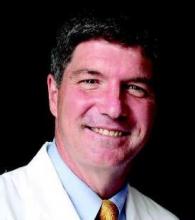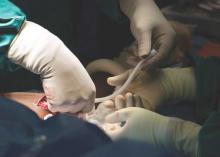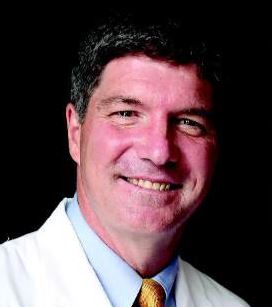User login
No indication of an immune response or structural failure was apparent at 6-month follow-up in the first-in-man trial of human tissue engineered vessels, according to Dr. Jeffrey H. Lawson. Dr. Lawson will discuss the current status of the bioengineered vascular tissue in his presentation entitled “Human Tissue Engineered Arterial Grafts Are Finally Working as Lower Extremity Bypasses and Dialysis Access: Why and Prospects for the Future.”
In collaboration with Dr. Laura Niklason, professor of anesthesia and biomedical engineering at Yale University School of Bioengineering and Applied Science, and Humacyte co-founder, Dr. Lawson, a vascular surgeon and professor of surgery at Duke University School of Medicine, Durham, N.C., has been instrumental in the development of the investigational human acellular vessel (HUMACYL, Humacyte, Inc.), and now serves as chief medical officer for Humacyte.
The device was developed to provide vascular access for patients with end-stage renal disease who require hemodialysis, and also has potential utility for reconstruction of arteries and vessels throughout the body, said Dr. Lawson, who also is vice-chair of research for the department of surgery at Duke.
The HUMACYL device has received fast-track designation by the Food and Drug Administration, and is in ongoing phase II trials in the United States and Europe. A global phase III study is planned in the coming months.
Dr. Lawson will review some of the key milestones from the pre-clinical and Phase II human trials.
The HUMACYL device is an implantable blood vessel engineered from donor vascular cells. The technology has evolved from early prototypes more than 2 decades ago to implantation in humans in the currently ongoing trials, he said.
The device, built upon a biodegradable polymer scaffold to guide tissue shape, involves the use of polyglycolic acid that is woven into a tube seeded with vascular smooth muscle cells. The initial scaffold degrades, leaving a blood vessel made implantable following removal of the original cellular antigens. This acellular structure allows incorporation of host cells, Dr. Lawson explained.
Trial, error and systematic science have led to the development of a more robust structure, with good suture retention and integrity.
In an ongoing open label, single-arm clinical trial, 6-month follow-up is currently available for the last of the implanted patients from three sites in Poland and three sites in the United States.
The device was used in these patients – end-stage renal disease patients who were not candidates for fistula creation – to provide upper arm arteriovenous access for hemodialysis. It was was used for dialysis between 4 and 8 weeks following implantation, and patients were monitored with monthly clinical evaluations and ultrasound for the first 6 months, and were followed for up to 2 years.
Dr. Lawson will discuss the findings in detail, but noted that initial data in 28 patients showed 100% secondary patency, and the 6-month findings showed no indication of immune response, no evidence of structural failure, no change in panel reactive antibody class 1 reactivity, and flow rates suitable for dialysis.
The phase III pivotal trial is being designed, he said, noting that the initial approval will be sought for use in the area of vascular access for dialysis.
The device also has potential use for reconstruction anywhere in the body; pre-clinical testing has been done in coronary and small-caliber arterial positions, Dr. Lawson said.
“The opportunities are endless. There is no reason to think we couldn’t make this tissue for arterial and/or venous use, anywhere in the body. We have experienced success with implantation in both animals and humans, with no immune rejection,” he said, adding that robust cellular re-population and good structural stability have been noted.
The exciting findings with respect to the HUMACYL device, which demonstrate that off-the-shelf bioengineered vascular tissues are possible, are non-immunogenic, and integrate with native tissues and repopulate and remodel, increasing in strength after implantation while having little intimal hyperplasia, are just the beginning, he said. The findings, he said, set the groundwork for more complex tissues to be developed in the future.
“This could make it possible for us to grow organs and other structures that are needed throughout the body,” he said.
Dr. Lawson has received consulting fees and research funding from Humacyte.
Session 47: New Techniques, Technology and Concepts
Human Tissue Engineered Arterial Grafts Are Finally Working as Lower Extremity Bypasses and Dialysis Access: Why and Prospects for the Future
7:27 a.m. – 7:32 a.m.
No indication of an immune response or structural failure was apparent at 6-month follow-up in the first-in-man trial of human tissue engineered vessels, according to Dr. Jeffrey H. Lawson. Dr. Lawson will discuss the current status of the bioengineered vascular tissue in his presentation entitled “Human Tissue Engineered Arterial Grafts Are Finally Working as Lower Extremity Bypasses and Dialysis Access: Why and Prospects for the Future.”
In collaboration with Dr. Laura Niklason, professor of anesthesia and biomedical engineering at Yale University School of Bioengineering and Applied Science, and Humacyte co-founder, Dr. Lawson, a vascular surgeon and professor of surgery at Duke University School of Medicine, Durham, N.C., has been instrumental in the development of the investigational human acellular vessel (HUMACYL, Humacyte, Inc.), and now serves as chief medical officer for Humacyte.
The device was developed to provide vascular access for patients with end-stage renal disease who require hemodialysis, and also has potential utility for reconstruction of arteries and vessels throughout the body, said Dr. Lawson, who also is vice-chair of research for the department of surgery at Duke.
The HUMACYL device has received fast-track designation by the Food and Drug Administration, and is in ongoing phase II trials in the United States and Europe. A global phase III study is planned in the coming months.
Dr. Lawson will review some of the key milestones from the pre-clinical and Phase II human trials.
The HUMACYL device is an implantable blood vessel engineered from donor vascular cells. The technology has evolved from early prototypes more than 2 decades ago to implantation in humans in the currently ongoing trials, he said.
The device, built upon a biodegradable polymer scaffold to guide tissue shape, involves the use of polyglycolic acid that is woven into a tube seeded with vascular smooth muscle cells. The initial scaffold degrades, leaving a blood vessel made implantable following removal of the original cellular antigens. This acellular structure allows incorporation of host cells, Dr. Lawson explained.
Trial, error and systematic science have led to the development of a more robust structure, with good suture retention and integrity.
In an ongoing open label, single-arm clinical trial, 6-month follow-up is currently available for the last of the implanted patients from three sites in Poland and three sites in the United States.
The device was used in these patients – end-stage renal disease patients who were not candidates for fistula creation – to provide upper arm arteriovenous access for hemodialysis. It was was used for dialysis between 4 and 8 weeks following implantation, and patients were monitored with monthly clinical evaluations and ultrasound for the first 6 months, and were followed for up to 2 years.
Dr. Lawson will discuss the findings in detail, but noted that initial data in 28 patients showed 100% secondary patency, and the 6-month findings showed no indication of immune response, no evidence of structural failure, no change in panel reactive antibody class 1 reactivity, and flow rates suitable for dialysis.
The phase III pivotal trial is being designed, he said, noting that the initial approval will be sought for use in the area of vascular access for dialysis.
The device also has potential use for reconstruction anywhere in the body; pre-clinical testing has been done in coronary and small-caliber arterial positions, Dr. Lawson said.
“The opportunities are endless. There is no reason to think we couldn’t make this tissue for arterial and/or venous use, anywhere in the body. We have experienced success with implantation in both animals and humans, with no immune rejection,” he said, adding that robust cellular re-population and good structural stability have been noted.
The exciting findings with respect to the HUMACYL device, which demonstrate that off-the-shelf bioengineered vascular tissues are possible, are non-immunogenic, and integrate with native tissues and repopulate and remodel, increasing in strength after implantation while having little intimal hyperplasia, are just the beginning, he said. The findings, he said, set the groundwork for more complex tissues to be developed in the future.
“This could make it possible for us to grow organs and other structures that are needed throughout the body,” he said.
Dr. Lawson has received consulting fees and research funding from Humacyte.
Session 47: New Techniques, Technology and Concepts
Human Tissue Engineered Arterial Grafts Are Finally Working as Lower Extremity Bypasses and Dialysis Access: Why and Prospects for the Future
7:27 a.m. – 7:32 a.m.
No indication of an immune response or structural failure was apparent at 6-month follow-up in the first-in-man trial of human tissue engineered vessels, according to Dr. Jeffrey H. Lawson. Dr. Lawson will discuss the current status of the bioengineered vascular tissue in his presentation entitled “Human Tissue Engineered Arterial Grafts Are Finally Working as Lower Extremity Bypasses and Dialysis Access: Why and Prospects for the Future.”
In collaboration with Dr. Laura Niklason, professor of anesthesia and biomedical engineering at Yale University School of Bioengineering and Applied Science, and Humacyte co-founder, Dr. Lawson, a vascular surgeon and professor of surgery at Duke University School of Medicine, Durham, N.C., has been instrumental in the development of the investigational human acellular vessel (HUMACYL, Humacyte, Inc.), and now serves as chief medical officer for Humacyte.
The device was developed to provide vascular access for patients with end-stage renal disease who require hemodialysis, and also has potential utility for reconstruction of arteries and vessels throughout the body, said Dr. Lawson, who also is vice-chair of research for the department of surgery at Duke.
The HUMACYL device has received fast-track designation by the Food and Drug Administration, and is in ongoing phase II trials in the United States and Europe. A global phase III study is planned in the coming months.
Dr. Lawson will review some of the key milestones from the pre-clinical and Phase II human trials.
The HUMACYL device is an implantable blood vessel engineered from donor vascular cells. The technology has evolved from early prototypes more than 2 decades ago to implantation in humans in the currently ongoing trials, he said.
The device, built upon a biodegradable polymer scaffold to guide tissue shape, involves the use of polyglycolic acid that is woven into a tube seeded with vascular smooth muscle cells. The initial scaffold degrades, leaving a blood vessel made implantable following removal of the original cellular antigens. This acellular structure allows incorporation of host cells, Dr. Lawson explained.
Trial, error and systematic science have led to the development of a more robust structure, with good suture retention and integrity.
In an ongoing open label, single-arm clinical trial, 6-month follow-up is currently available for the last of the implanted patients from three sites in Poland and three sites in the United States.
The device was used in these patients – end-stage renal disease patients who were not candidates for fistula creation – to provide upper arm arteriovenous access for hemodialysis. It was was used for dialysis between 4 and 8 weeks following implantation, and patients were monitored with monthly clinical evaluations and ultrasound for the first 6 months, and were followed for up to 2 years.
Dr. Lawson will discuss the findings in detail, but noted that initial data in 28 patients showed 100% secondary patency, and the 6-month findings showed no indication of immune response, no evidence of structural failure, no change in panel reactive antibody class 1 reactivity, and flow rates suitable for dialysis.
The phase III pivotal trial is being designed, he said, noting that the initial approval will be sought for use in the area of vascular access for dialysis.
The device also has potential use for reconstruction anywhere in the body; pre-clinical testing has been done in coronary and small-caliber arterial positions, Dr. Lawson said.
“The opportunities are endless. There is no reason to think we couldn’t make this tissue for arterial and/or venous use, anywhere in the body. We have experienced success with implantation in both animals and humans, with no immune rejection,” he said, adding that robust cellular re-population and good structural stability have been noted.
The exciting findings with respect to the HUMACYL device, which demonstrate that off-the-shelf bioengineered vascular tissues are possible, are non-immunogenic, and integrate with native tissues and repopulate and remodel, increasing in strength after implantation while having little intimal hyperplasia, are just the beginning, he said. The findings, he said, set the groundwork for more complex tissues to be developed in the future.
“This could make it possible for us to grow organs and other structures that are needed throughout the body,” he said.
Dr. Lawson has received consulting fees and research funding from Humacyte.
Session 47: New Techniques, Technology and Concepts
Human Tissue Engineered Arterial Grafts Are Finally Working as Lower Extremity Bypasses and Dialysis Access: Why and Prospects for the Future
7:27 a.m. – 7:32 a.m.


